戈叔亚 二战中缅印战区历史研究,跑遍研究所涉及的所有地区。远征军所触及的每一块土地,有些地方历史还在延续

注:除非译者,也就是我特别注明,否则全部文字为这位美国佬的文字。戈叔亚 在美国发现一组昆明老照片
(二)
现在把这组照片和文字(翻译)全部刊登
中缅印战区——被遗忘的战场(图片)
作者:Frank Vierling
1943-1945
摘自:中缅印战区网站
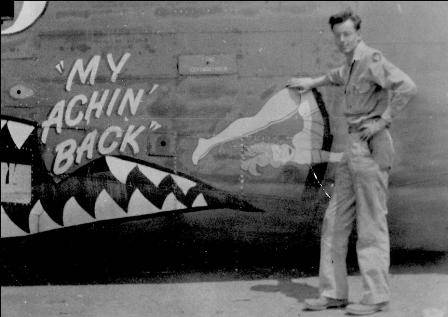
在这幅绘画前作一个恶作剧的动作
A little fun down at the “boneyard.”

1944年圣诞节,我们扩展的人员在我们的通信站聚会。宴会的食品是空运来的。
Christmas 1944, our greatly enlarged crewenjoying a holiday party in our transmitter building. We saved our“care” packages from home for this super feast.

有一队中国士兵不时来我们的营地巡逻。哨棚是一个通信设备的包装箱。动力设备的绝缘瓷瓶在后面。
We had a small contingent of Chinesesoldiers that patrolled our grounds. The guard shack was atransmitter shipping crate. The motor generator building’s tileroof is in the background.

工人们在马可波罗路(指昆明通向滇西的路,也就是滇缅公路戈叔亚注)上,这条路在我们的通信站和动力站之间。照片右边的帐篷是我们中国卫兵的。
Workers traveled the Marco Polo Road whichran between our transmitter and power generator buildings. The tenton the right was for our Chinese guards.
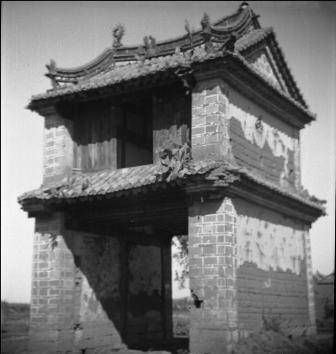
每一个最贫穷的村庄都有一个寨门。这个寨门正好在我们旁边的路上。

Even the poorest villages had an entrancegate. This one was for a village just down our road.
村庄一景,注意看村寨的大门,在照片的右上边。

Village scene, note the village gate,upper right.
我不知道这位妇女在干什么——我猜想是纺织。在这个三角架和一个三角架之间有一些线,她们这样把乡间的小路堵塞了。
(戈叔亚注:确切说是在纺线。两个三角架之间的横杆上有许多线,每一根线下面悬挂着一个陀螺,妇女们飞快旋转它们,或者所有的线安置在一个旋转的手柄上。一个人摇动手柄就可以纺线了。看到这里我非常惊讶和高兴,因为我们小时候还可以看到。如果没有这张照片,我们昆明人也许和我一样,早就忘记了!)
I don’t know what this woman is doing -weaving, I suppose. There are lines between this tripod and anotherdown the lane which you can’t make out.
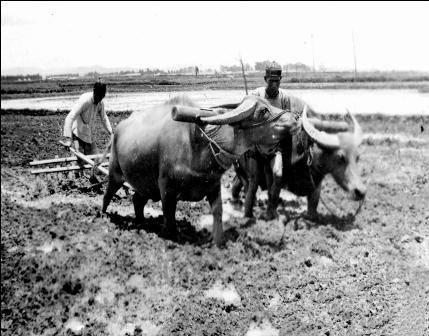

我们差不多每一个晚饭都吃水牛,吃起来很硬。有点像“索尔兹伯里牛排”。(戈叔亚注:原文就是“吃水牛”。那时云南老百姓为美国大兵提供包括牛肉在内的食物是一个天大的负担。美国兵不喜欢吃水牛,老百姓更不愿意,因为这是“生产工具”。我看过一个资料,每天云南政府为喂这些美国大兵食物是非常头痛的。其中最麻烦的就是牛肉!)
Weate Water Buffalo for dinner almost every night, as, a sort oftough, “Salisbury Steak.”

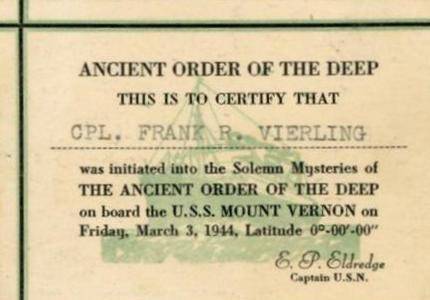
首次越过赤道的海员象征性的组织(过去他们没有穿越赤道),送给在船上的军人,成为了“老水手”。
Asymbolic group of POLLYWOGS (those who had not crossed the Equatorbefore), representing all the troops on board, became SHELLBACKS bytheir ceremonious induction into the "Ancient Order of the Deep."

The job of Butter Cutter was a cushy one -two 5-man shifts worked alternate days cutting tub butter intopatties. This gave us access to extra "goodies" from the galley andentry to the sailors version of an Army Post Exchange.

昆明大街一景,可能是结婚,或者轿子里面是一个有钱的太太。
Kunming street scene, might be a weddingor just a wealthy lady passing by.
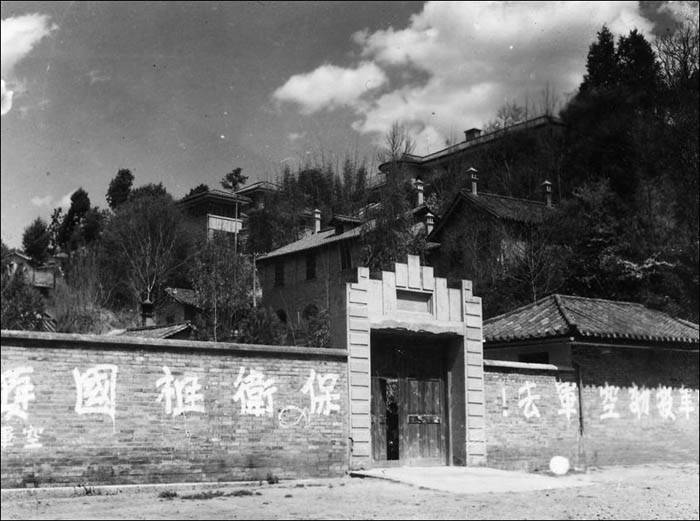
一个单位的大门——大门的左边写着:“保卫祖国”。右边写着“支持空军去”(英文原文如此)。
Agated community - the characters on the left read, “Defend theCountry” and on the right, “Support the AirForce.”

昆明主要大街的一个牌楼,牌楼的一边被日本飞机炸毁。这个牌楼在中国的文化革命时期被拆毁。
A gateway on the main street in Kunmingshowing Japanese bomb damage. The gate was demolished during thecultural revolution.
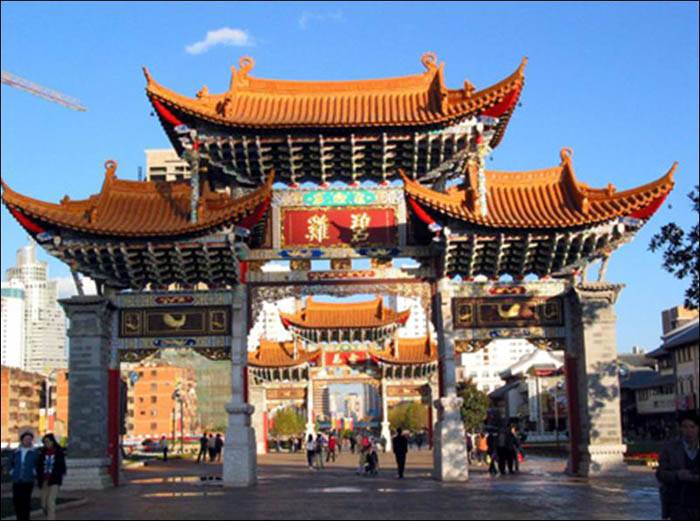
文革后,牌楼再次恢复。这张照片是一个昆明的学生拍摄的,我的女儿在去韩国时路过这里。

Since the revolution, the gate has beenrebuilt. This picture was sent to me by a young Kunming student mydaughter met on a business trip to Korea.
通往昆明的路。城市里也是黄包车。
The road to Kunming. The city was just arickshaw ride away.

昆明的电报大楼
Kunming’s telephonebuilding
(戈叔亚注:电报大楼听说在现在的近日公园,也就是百货大楼,实际上它是昆明古城的南城门。但是我从来没有见过。据说这里过去是非常热闹的地方。城楼的墙上是粘贴各种海报传递新闻的地方。城楼下面四周据说是农民来买鲜花的地方。)
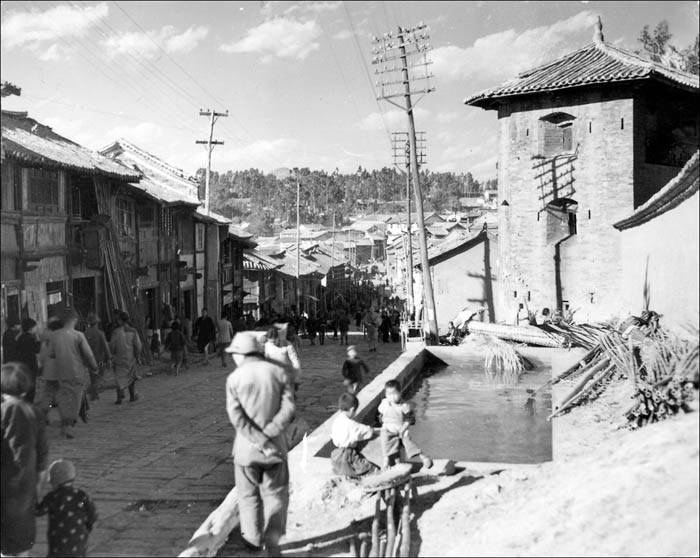
昆明一景,旁边的水池是防空消防用的,旁边还有一些芦苇用来编织。
Kunming street scene with soaking tank forsoftening bamboo and reeds for weaving.
(戈叔亚注:这大概是武城路,直到几年前这里才被拆毁,长期以来,这条街道是昆明最有味道的。)
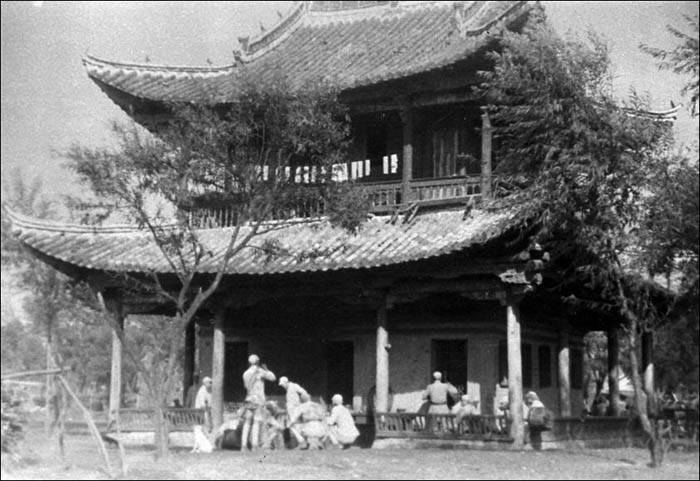
昆明公园的茶馆
Tea House in Kunming’s CityPark
(英文是昆明市立公园的意思。市立公园在那里?估计是翠湖公园,或者是大观楼。戈叔亚)

士兵们在茶馆休息
Soldiers taking a “Tea Break” at the TeaHouse

公园湖泊
View from across the parklake.
(这里当然是大观楼公园,如今这里和照片上一模一样。戈叔亚)

昆明的电影院,进入昆明所看到的第一流的建筑。
Kunming’s cinema, one of the firstbuildings you see when entering the city.
(这是南屏街电影院,现在仍然一模一样。老人说,这条街二战时期也叫"GIStreet",也就是美国兵大街的意思。那时是昆明最繁华的地方。

中国银行,也有职员公寓。
The Bank of China, with offices andapartments.
(这里是近日公园百货大楼对面的老昆明最有名的建筑,已经消失了。)
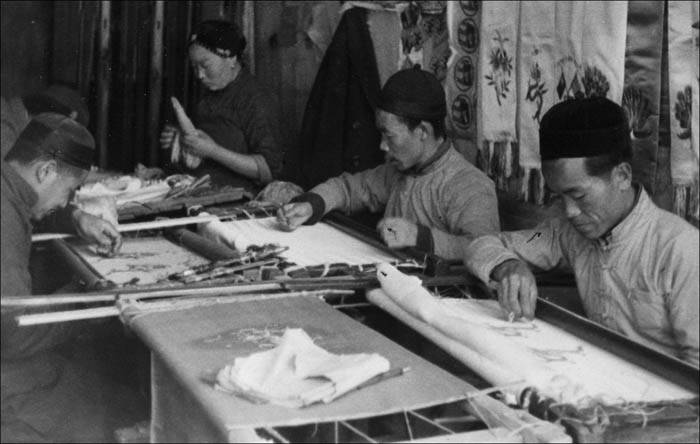
昆明主要街头的一个敞开的刺绣店面。男人们似乎都在做针线活。
Open storefront embroidery shop onKunming’s main street. Men seemed to do most of the needlework.

邛竹寺,坐黄包车到城里,可以挑选一个小船做穿越滇池的旅行。
A days outing to the Qiongzhu Templesstarted with a rickshaw ride to the city and selecting a boat andoarsman for the trip across Lake Dianchi.
(这个地方应该是篆塘,是老昆明上船到大观楼或者进入滇池,可以通向许多地方的码头。现在可以好像还在。冬天有许多海鸥在这里。戈叔亚)


(这里可能是篆塘。也就是大观河)
这里有许多小船可以挑选。
Along the river there are lots of boats tochoose from.

我们挑选了一个有女划桨手和她的小儿子的船,带我们到寺庙。
We picked out an oarswoman and her youngboy to ferry us to the temples.
(从下面的照片看,小船带这位美国大兵去的地方应该是西山的寺庙——太华寺等。戈叔亚)
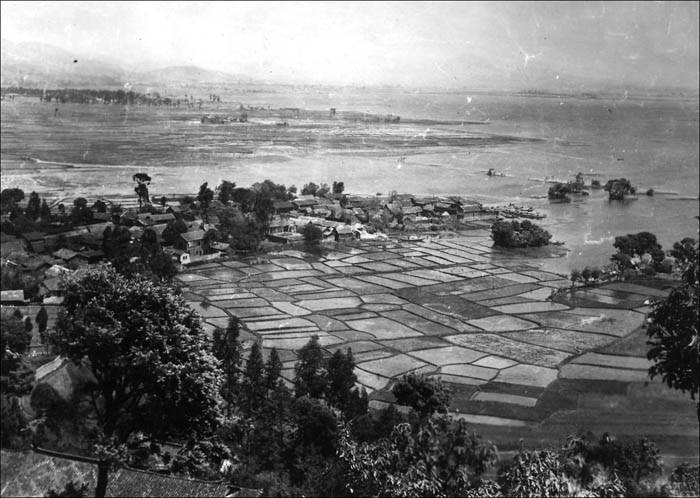
我们爬到山上俯瞰滇池。宁静的村庄、湖泊和稻田
Looking back at Lake Dianchi as we startup the mountain. The village, lake and rice paddies made a tranquilscene.
这里就是在西山太华寺的如上拍摄的。戈叔亚

你可以看到寺庙,进入每一个寺庙都要脱鞋,或者是脱穿烂的草鞋,然后再花几个铜钱就可以买一双新的草鞋,这样就象征着在生命重新开始时得到了神的祝福。
Looking back you see the shrines, atintervals, along the trail. At each shrine there were discardedshoes and rice-straw sandals. For a few coins, new footwear couldbe purchased, symbolizing Gods blessing for a fresh start inlife.

沿途更多的庙宇
Looking up at more trailsideshrines.

到达主要的大殿,你可以穿过寺庙的大门进入这个花园。
Arriving at the main shrine, you passthrough the temple gate into this garden.
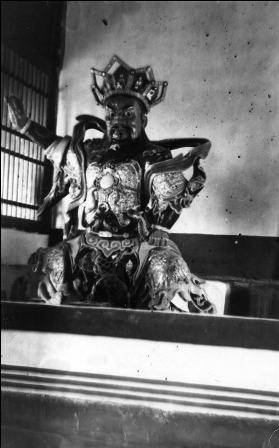
大门总是有神仙守卫着。
There are always Gods guarding templegates.
Copyright ©2014-2023 krzzjn.com All Rights Reserved
湘ICP备18022032号 湘公网安备43010402000821号
不良信息举报电话:0731-85531328 19198230121(微信同号)
纠错电话:18182129125 15116420702
QQ:2652168198